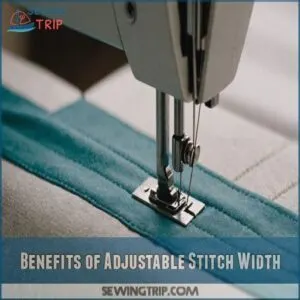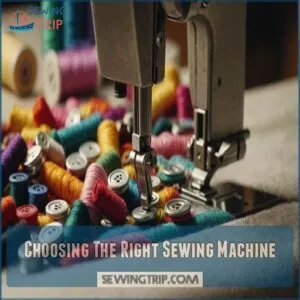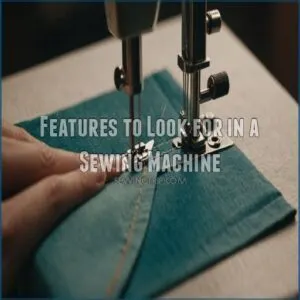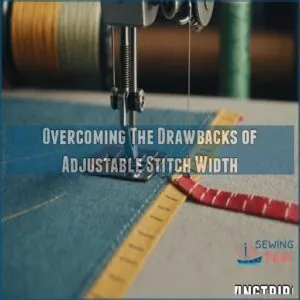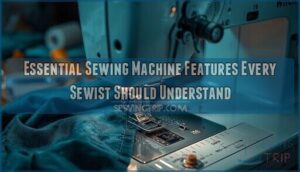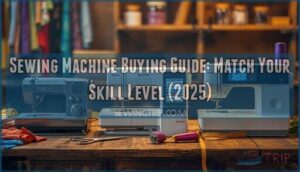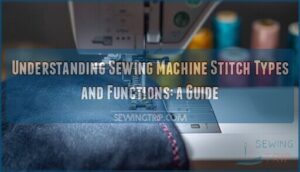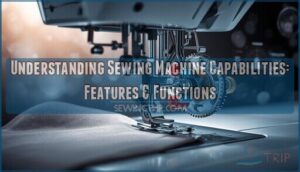This site is supported by our readers. We may earn a commission, at no cost to you, if you purchase through links.
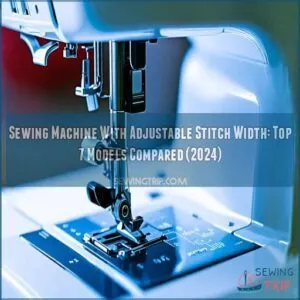
These machines let you customize your stitches from ultra-narrow (perfect for delicate seams) to extra-wide (ideal for decorative touches).
Think of it like having a magic paintbrush that can create both fine lines and bold strokes.
Modern models like the Singer Heavy Duty and Brother CS7000X make it easy to adjust settings with simple dials or digital controls.
While basic machines limit you to fixed widths, adjustable models open up possibilities from hemming silk scarves to crafting sturdy denim bags.
Table Of Contents
Key Takeaways
- You’ll gain precise control over your sewing projects with adjustable stitch width, letting you create everything from delicate seams on silk to decorative patterns on denim.
- Your stitch width range matters – basic machines offer 0-5mm, mid-range machines 0-7mm, and professional models up to 9mm width adjustment.
- You’ll find modern machines like the Singer Heavy Duty and Brother CS7000X make width adjustments simple through digital controls or dials, while offering additional features like automatic threading.
- You’ll need to match your machine’s capabilities to your projects – consider fabric types you’ll work with, frequency of use, and whether you need basic utility stitches or decorative options.
Benefits of Adjustable Stitch Width
You’ll find that adjustable stitch width gives you complete control over your sewing projects, letting you create everything from delicate seams to bold decorative patterns.
With this feature, you can easily switch between narrow stitches for precise work on lightweight fabrics and wider stitches for securing heavy materials or adding eye-catching embellishments.
Customization Options for Sewing Projects
With adjustable stitch width, you’ll open up countless possibilities for your sewing projects.
You can create delicate pintucks for vintage-inspired blouses, add decorative topstitching to denim, or craft intricate appliqué designs on quilts.
Whether you’re working on home décor, fashion pieces, or craft projects, you’ll have the freedom to customize your stitches to match any style or design requirement you envision.
Enhanced Control Over Stitch Quality
Through adjustable stitch width, you’ll gain precise control over your sewing quality.
You can fine-tune stitch density for perfectly balanced seams and create consistent patterns that look professionally made.
Proper width adjustments let you maintain ideal thread tension and prevent puckering.
Plus, you’ll get cleaner buttonholes and decorative stitches every time.
It’s like having a precision tool that responds to your exact needs.
Suitable for Various Fabric Types
Adjustable stitch width settings let you adapt to different fabric weights without breaking threads or damaging materials.
Moving beyond basic stitch control, this feature helps you master various fabric types – from delicate silks to heavy denims.
For best results, explore a wide range of adjustable stitch machines.
- Fine fabrics need narrow stitches with lower tension
- Medium-weight cottons work best with standard width settings
- Heavy materials require wider stitches and stronger thread
Your projects stay professional-looking and durable, regardless of the fabric choice.
Top 7 Sewing Machines With Adjustable Stitch Width
You’ll find our carefully selected lineup of sewing machines that offer the perfect balance of adjustable stitch width and reliable performance, ideal for tackling various sewing tasks, such as troubleshooting zigzag stitches. You’ll find our carefully selected lineup of sewing machines that offer the perfect balance of adjustable stitch width and reliable performance.
From the versatile Janome MOD 15 to the user-friendly Brother Computerized model, these seven machines let you customize your stitches with precision and ease.
1. Janome MOD 15 Sewing Machine
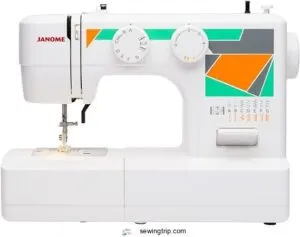
The Janome MOD 15 packs impressive features into its compact 11.7-pound frame.
You’ll appreciate its 15 built-in stitches, including a four-step buttonhole that’s perfect for garment making.
The automatic tension system takes the guesswork out of thread adjustment, while the top-loading bobbin with clear cover lets you monitor your thread supply.
The machine’s 5-piece feed dog system provides smooth fabric feeding, and you can easily adjust stitch length and zigzag width for precise control.
Plus, with four presser feet included, you’re ready to tackle various projects right out of the box.
Best For: The Janome MOD 15 is best for beginners and hobbyists who need a reliable and easy-to-use machine for basic sewing projects.
- Easy to use with automatic tension and a top-loading bobbin.
- Good value for the price with a range of features.
- Compact and lightweight, making it easy to store and transport.
- Not suitable for heavy fabrics.
- Some users have reported missing parts and power supply issues.
- May not be as durable as more expensive machines.
2. SINGER Tradition 2277 Sewing Machine

Singer’s Tradition 2277 sewing machine packs 23 built-in stitches and a user-friendly automatic needle threader into a lightweight frame.
You’ll appreciate its adjustable stitch length and width controls, making it perfect for customizing your projects.
Like the Singer 2259 Tradition, it features a sturdy metal frame, offering a good balance between durability and portability, as seen in the Singer 2259 Tradition review.
The one-step buttonhole feature and three snap-on presser feet help you tackle diverse sewing tasks efficiently.
While it may dance a bit at high speeds due to its light build, its all-metal bobbin casing provides durability.
For beginners or as a backup machine, this model offers solid value with essential features you’ll actually use.
Best For: Beginners, occasional sewers, and those looking for a lightweight and affordable sewing machine.
- Easy to use with features like automatic needle threading and a one-step buttonhole.
- Durable construction with a metal bobbin casing.
- Offers good value for the price with essential features.
- Can be a bit wobbly at high speeds due to its lightweight design.
- The reverse stitch lever placement is unusual.
- Limited to basic stitches.
3. Mini Sewing Machine for Beginners
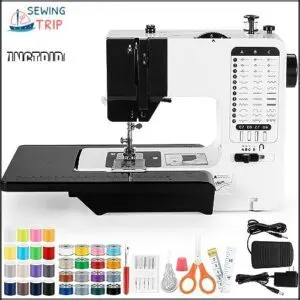
Looking for a portable powerhouse? BUXFMHT’s Mini Sewing Machine packs 38 stitch patterns into a compact frame that won’t break the bank.
You’ll appreciate its double-thread system and adjustable speeds, making it perfect for learning the ropes.
The preset stitch widths take the guesswork out of basic projects, while the reverse sewing function adds versatility.
Though it might struggle with thick fabrics, its hard stainless steel construction and quality PP shell guarantee durability.
With a 12-month guarantee and included testing fabric, you’re set for your sewing journey.
This mini sewing machine is great for those following best sewing machine beginner tips to master their machine. This mini sewing machine is best for beginners and those looking for a portable option for basic home sewing projects.
- Comes with a complete kit, including tools and testing fabric.
- Offers 38 stitch patterns with adjustable speeds for creative flexibility.
- Built with durable materials and backed by a 12-month warranty.
- May not handle thick fabrics effectively.
- Some users reported issues with bobbins, although these were resolved.
- While compact, it might not be as powerful as larger sewing machines.
4. Singer Heavy Duty Sewing Machine
When tough fabrics meet their match, the Singer Heavy Duty sewing machine stands ready with enhanced piercing power and a stronger motor.
You’ll breeze through multiple layers of denim and canvas at speeds up to 1,100 stitches per minute.
With 110 stitch applications and a one-step buttonhole feature, you’re in complete control of your projects.
The top drop-in bobbin system keeps things running smoothly, while the built-in needle threader saves your eyes from strain.
Plus, its full metal frame provides rock-solid stability for years of reliable service.
Best For: To achieve professional-looking seams, it’s essential to understand how to use a sewing machine, learning techniques such as adjusting the thread tension dial for balanced stitches. The Singer Heavy Duty Sewing Machine is best for beginners and intermediate sewers who need a sturdy machine for handling thicker fabrics like denim and canvas.
- Powerful motor for sewing through multiple layers of thick fabric.
- Wide variety of stitch options for different projects and materials.
- Durable metal frame for long-lasting use.
- May not be suitable for advanced sewers who prefer computerized machines.
- Some users report issues with the upright spool pin causing thread jams.
- May require a transformer for use outside of the USA.
5. Brother XM2701 Sewing Machine
The Brother XM2701 offers 27 built-in stitches to expand your creative possibilities.
You’ll appreciate its user-friendly features, including an automatic needle threader and jam-resistant drop-in top bobbin that make setup a breeze.
The free arm design adapts perfectly to various projects, while six included sewing feet give you versatility.
With Brother’s reliable support system and complete accessories package, you’re never left hanging.
Though not a dedicated quilting machine, it handles basic quilting tasks well.
The affordable price point makes it an excellent choice for beginners seeking quality and reliability.
Best For: The Brother XM2701 is best for beginners and those seeking a user-friendly machine with a wide range of stitches and features at an affordable price.
- User-friendly features like automatic needle threading and a drop-in top bobbin.
- Versatile with 27 built-in stitches and six included sewing feet.
- Affordable price point for the features offered.
- Some users have concerns about the plastic presser foot lever’s durability.
- Not a dedicated quilting machine, though it can handle basic quilting tasks.
- Warranty is voided if used outside the US or with a different voltage.
6. Brother CS7000X Sewing Quilting Machine
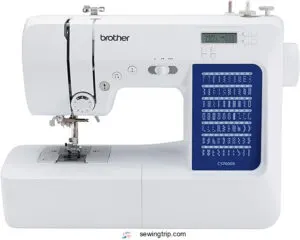
Inside the Brother CS7000X, you’ll find 70 built-in stitches that give you plenty of creative freedom.
Its improved automatic needle threader takes the frustration out of getting started, while the durable metal frame guarantees your machine stays steady during complex projects.
You’ll appreciate the wide table for quilting and the included 10 sewing feet that help tackle various tasks.
The large needle-to-arm workspace makes handling bulky fabrics a breeze, and with a 25-year warranty, you can sew confidently knowing your investment is protected.
Best For: The Brother CS7000X is best for beginner sewers and quilters who want a user-friendly, versatile, and durable machine with a wide range of features.
- Easy to use for beginners and experienced sewers alike.
- Durable metal frame construction ensures longevity.
- Includes a wide range of accessories, including a wide table and 10 sewing feet.
- Some users have reported the machine being too slow.
- Some users have found the automatic bobbin threader difficult to use.
- Some users have found the machine to be too lightweight.
7. Brother Computerized Sewing Quilting Machine
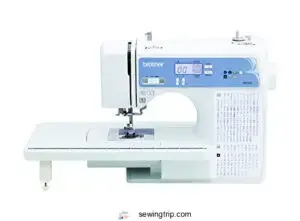
You’ll love Brother’s XR9550 computerized machine, packed with 165 built-in stitches for endless creative possibilities.
This intermediate-friendly model boasts an automatic needle threader, drop-in bobbin, and clear LCD screen for easy stitch selection.
While lightweight at 10.1 pounds, it includes a wide table perfect for quilting projects.
Though the hard case isn’t ideal for transport and it struggles with thick fabrics, its quiet operation and one-touch buttonhole feature make up for these minor drawbacks.
Plus, you’re backed by a 25-year warranty and lifetime technical support.
Best For: This machine is best for intermediate to expert seamstresses who want a variety of stitch options and easy-to-use features.
- Lightweight and easy to move
- Easy to use and learn
- Variety of stitches and embroidery options
- Hard case is not a carrying case
- Pressure foot tension cannot be easily adjusted for thicker materials
- Lacks essential accessories like quilting feet
Choosing The Right Sewing Machine
You’ll need to match your sewing machine’s capabilities with your specific project requirements to make the right choice.
When you’re selecting a machine with adjustable stitch width, consider factors like stitch variety, ease of use, and whether the machine can handle your preferred fabric types.
Determining Sewing Project Requirements
Before picking your next sewing machine, take stock of what you’ll actually make.
Consider your fabric choices – from lightweight silks to heavy denims.
Think about project difficulty levels you’re comfortable tackling.
Map out how much time you can dedicate to sewing each week.
Factor in available workspace and storage.
Most importantly, be honest about your skill level and growth goals.
Assessing The Range of Stitch Options
After planning your sewing goals, take a close look at the stitch options available, including machines with adjustable stitch width and density, such as computerized sewing machines.
Modern machines offer an impressive range of capabilities that’ll make your projects shine:
- Basic utility stitches for everyday sewing and mending
- Decorative stitches for adding flair to garments and home décor
- Stretch stitches for working with knit fabrics and creating lasting seams
Consider which stitch types you’ll use most frequently.
Verifying Stitch Length and Width Range
Checking stitch length and width ranges sets you up for success with different fabrics and projects.
Let’s look at typical ranges that match your needs:
| Machine Type | Length Range | Width Range |
|---|---|---|
| Basic | 0-4mm | 0-5mm |
| Mid-Range | 0-5mm | 0-7mm |
| Professional | 0-7mm | 0-9mm |
For most home sewing projects, a mid-range machine offers the sweet spot between versatility and control.
Considering User-Friendliness
The right sewing machine should feel like a natural extension of your hands.
Focus on models with clearly labeled buttons, intuitive menus, and straightforward controls.
You’ll want a machine that doesn’t require consulting the manual for basic operations.
Look for features like one-touch stitch selection, easy threading guides, and a clear LCD display that shows your settings at a glance.
Features to Look for in a Sewing Machine
You’ll want to focus on key features that match your sewing needs when choosing a machine, including stitch options, controls, and automated functions.
A good sewing machine should offer multiple built-in stitches, including a zigzag stitch with adjustable width and length, like why sewing machine sew zigzags, which is essential for various sewing tasks, user-friendly controls, an automatic needle threader, and a clear LCD display for easy viewing of your settings.
Multiple Stitch Options
When choosing a sewing machine, stitch variety acts as your creative palette.
Consider investing in a variable stitch width machine, providing control over stitch length and width for various tasks (variable stitch width options.
Modern machines like the Singer Quantum Stylist 9960 offer up to 600 built-in options, including decorative stitches for embellishments, utility stitches for everyday tasks, and stretch stitches for knit fabrics.
You’ll want a wide stitch library that covers basic seams, including the versatile zigzag stitch technique, buttonholes, and decorative patterns.
Look for machines offering stitch editing capabilities for customization.
Easy-to-Use Controls
Beyond multiple stitches, user-friendly controls make all the difference in your sewing experience.
Simple navigation lets you focus on creativity rather than fumbling with complicated settings.
- Large, clearly labeled buttons make stitch selection intuitive
- Digital displays show your current settings at a glance
- Well-spaced control panels prevent accidental changes
- Front-mounted dials offer quick access to common adjustments
Look for machines with straightforward control layouts that feel natural to use – you’ll spend less time reading manuals and more time creating.
Automatic Needle Threader
Say goodbye to squinting and struggling with tiny needle eyes.
Automatic needle threaders save your time and eyesight, making threading as simple as pulling a lever.
You’ll find two main types: built-in threaders that work with a hook mechanism, and handheld threaders for portable convenience.
Look for models with robust metal threaders rather than plastic ones, as they’ll last longer and handle different thread sizes better.
LCD Display
A clear LCD display lights up your sewing journey by showing your stitch selections at a glance.
You’ll love how it previews your stitch patterns before you start sewing, saving time and preventing mistakes.
The backlit feature makes it easy to see settings in any lighting, while intuitive icons help you navigate through stitch options effortlessly.
Plus, it displays helpful reminders about needle position and presser foot recommendations.
Overcoming The Drawbacks of Adjustable Stitch Width
You’ll find that adjustable stitch width machines can be complex to operate and maintain, but with the right approach, you can master their settings.
You can overcome common issues like higher costs and maintenance needs by choosing a model that matches your skill level and following regular care routines.
Managing Complexity
Modern sewing machines with adjustable stitch width don’t have to be overwhelming.
Start with the basic stitches and gradually explore new features using your machine’s user guide.
Many models offer simplified controls and built-in tutorials to help you master each function.
Take advantage of online learning resources and YouTube videos that walk you through specific techniques step-by-step.
Balancing Price and Quality
Finding that sweet spot between price and quality doesn’t have to break the bank.
When shopping for a sewing machine with adjustable stitch width, consider these value-focused tips:
- Look for mid-range models that offer essential features without fancy extras
- Watch for seasonal sales and bundle deals from reputable retailers
- Compare warranty coverage – longer warranties often indicate better build quality
The key is focusing on features you’ll actually use rather than paying for bells and whistles you won’t need.
Maintaining The Machine
Keep your adjustable stitch width machine running smoothly with regular maintenance, and for specific parts and tools, check out your options for adjustable stitch width maintenance.
Set a monthly cleaning schedule to remove lint and dust, especially around the bobbin area.
Establish an oiling routine based on your machine’s manual, typically every 3-4 weeks of regular use.
Replace needles after 6-8 hours of sewing, and keep your bobbin case clean to prevent thread jams.
Frequently Asked Questions (FAQs)
How to adjust stitch width on sewing machine?
Quick as a thread through a needle, you’ll locate the stitch width dial on your machine’s front panel.
Turn it left for narrower stitches or right for wider ones, testing first on scrap fabric.
What is a stitch width regulator on a sewing machine?
A stitch width regulator lets you control how wide your stitches appear on fabric.
You’ll find this dial or button on your machine’s front panel – it’s essential for creating decorative patterns and zigzag stitches.
Which parts of sewing machine is using for adjust stitch length?
You’ll find the stitch length dial or slider on your machine’s front panel.
It lets you adjust how close together your stitches are, usually with numbers from 0-5 indicating millimeters between stitches.
What is stitch selector sewing machine?
A stitch selector lets you choose different stitch patterns on your machine.
You’ll find it as a dial or digital display where you can pick straight, zigzag, decorative, or utility stitches for your project.
How do you adjust stitch width while sewing?
Adjusting the stitch width is crucial, especially when using the overlock stitch for stronger seams on stretchy fabrics, as seen in common sewing machine symbols. Modern sewing machines allow 95% more stitch width control than vintage models.
To adjust width while sewing, locate your machine’s width dial or button, typically above the needle area, and turn it gradually while stitching continues.
Can adjustable width stitches work on all fabrics?
Adjustable width stitches work best on medium-weight fabrics. You’ll need to test settings on delicate or heavy materials, as some fabrics can pucker or skip stitches with certain width adjustments.
Whats the ideal stitch width for hemming?
For basic hems, start with a 5mm width – it’s your sweet spot.
You’ll want to go wider (3-4mm) for decorative edges or thicker fabrics, and narrower (5-2mm) for delicate materials.
Does wider stitch width affect thread tension?
Yes, your stitch width can impact thread tension.
When you’re using wider stitches, you’ll need to adjust your tension slightly higher to maintain proper thread balance and prevent loose, sloppy-looking stitches.
When should you use maximum stitch width?
You’ll want maximum stitch width for decorative stitches, appliqués, and satin edging.
It’s also perfect when you’re creating bold zigzags for stretch fabrics or securing wide trims and elastic bands.
Conclusion
While you might worry about mastering adjustable settings, today’s sewing machines with adjustable stitch width make it surprisingly easy to create professional-looking projects.
Whether you’re hemming delicate fabrics or adding decorative touches, these versatile machines give you the control you need.
By choosing from our recommended models and following the buying guide, you’ll find a sewing machine that matches your skill level and project needs.
Start exploring these options, and you’ll be crafting like a pro in no time.

